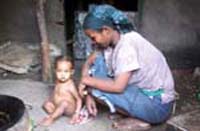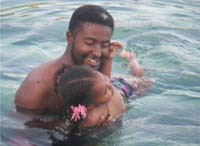6.2 Steps in learning
As a member of your community, you have been living closely with mothers and children and you will have also observed how children explore and learn from their surroundings. Based on that you can get some useful ideas about learning by thinking about how babies and young children learn. They often have confidence in themselves and are still full of the joy of learning (Figure 6.3). At their best adults also learn in similar ways.

Next time you have a chance to observe small children learning and playing, see if you can identify some the steps they go through.
Box 6.1 gives you some idea of the sequence of children’s learning. Read it through and compare it to your own observations.
Box 6.1 Steps in childhood learning
- The first step is observation, (watching) very carefully.
- Next, they also try to use other sensing methods like listening, touching or tasting.
- They will start to ask ‘why?’ ‘how?’ when something happens.
- The next step is to imitate or copy the same action saying, ‘Let me do it myself’.
- Learning takes place by repeating the action again and again (Figure 6.4).
- Children usually start to ask others to observe them so they can show that they are able to do the activity they have just learnt.
- Perform the action for themselves, having learnt something.

6.1 Characteristics of learning
